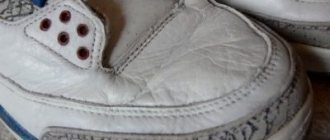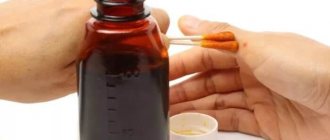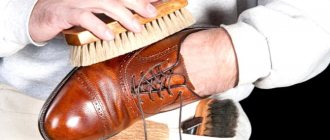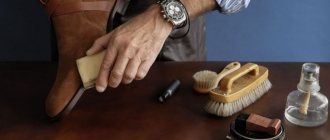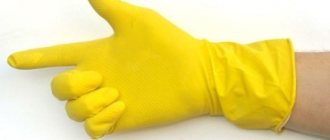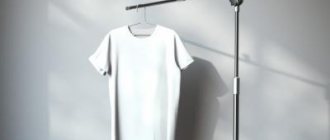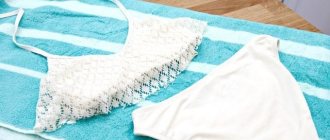Home / Care
Back
Published: 06/12/2021
Reading time: 2 min
0
14
During wear, folds and wrinkles appear on any shoe, giving it a sloppy appearance. Over time they become deeper and then crack. It is impossible to save such a couple. But removing creases from leather shoes is not so difficult.
- 1 Fighting creases 1.1 Fine wrinkles
- 1.2 Large
How to remove cracks, scratches and dents from shoes, sneakers or boots
As a result of improper care or its complete absence, not only wrinkles, but also cracks and scratches may appear on the surface of suede, natural or artificial eco-leather. In such cases, you should not be too upset, since the problem has a solution.
What do you need for work?
- “Liquid Skin” product of a suitable color;
- small rubber spatula;
- wax or paraffin (for scratches);
- sandpaper grit P200-P240 - marking according to the new GOST 3647-80 or diamond mesh;
- technical or medical alcohol (white spirit is possible);
- shoe cream of the desired color.
How to get rid of cracks
- Let's figure out how to smooth out folds on leather shoes in which cracks have appeared (they can form between wrinkles or at the top of the crest of the deformation). First you need to find and buy a special restoration product called “Liquid Skin”. But it must match the color of your shoes, otherwise there will be stripes on the surface, which is also a defect.
- Thoroughly wash your boots, boots or shoes from dirt and grease, and dry your shoes at room temperature. You should not keep it near a radiator or open fire - it may warp.
- In the section “How to smooth out (remove) defects” you have already learned how to remove wrinkles from leather shoes, so first you need to smooth out the wrinkles with an iron. Allow time for the surface to cool to room temperature.
- Sand the damaged areas with sandpaper to smooth out the jagged edges (just be careful - if you overdo it, you will make the problem worse). Treat the surface for degreasing with alcohol or white spirit.
- Apply “Liquid Skin” in the right places. To do this, use a rubber spatula and the “scrape” method so that the product fills the recesses, but does not remain on the surface.
- Wait 5-10 minutes and evaluate the result, but if it turns out to be unsatisfactory, repeat everything again, starting with sanding.
- After drying, treat the shoes with a suitable cream and wear them for your pleasure, without remembering the previous problem.
Tip: when you have sandpaper at home, but you don’t know the grit number, you can determine it yourself. Try sanding a small section of a plastic or wooden student ruler. If there are no deep marks left, then everything is in order - the abrasive is suitable for you.
How to get rid of scratches
Such defects can appear from wire, glass, sharp branches, stones, etc. Assess the depth of the damage by running your fingers, and if you don’t feel anything, you can repair it with shoe polish. Otherwise, use this algorithm:
- Just like a crack, clean the scratch with sandpaper and degrease with alcohol or white spirit.
- Warm the wax until it is pliable in your hands. Rub the damaged area and remove excess with a soft cloth.
- If the scratch turns out to be too deep, then treat it in the same way as with a crack - repair it with “Liquid Leather” using a rubber spatula.
- Treat with a cream of a suitable color and continue using the pair.
Useful tips
When restoring shoes that have lost their original appearance, you should know some of the subtleties of the procedures themselves.
- So, wax is used only in metal jars. If it is offered in the form of an aerosol, then in this case this thing is absolutely useless.
- It is best to use kitchen paper towels as shoe filler.
- To speed up drying of shoes, you can use a hair dryer.
- Before you start treating the surface with “liquid leather”, you should test it on a small area.
How to restore the appearance of suede on shoes?
Shoes with stains, bald spots or faded lint no longer look attractive. Such defects immediately catch the eye of others, so you no longer want to wear such a pair. However, you shouldn’t throw away suede shoes either. There are many methods for restoring your favorite shoes or boots to their original appearance.
You can restore the attractiveness of products using special products or solutions prepared from available substances. At home, you can not only clean your boots and boots, but also restore their rich color. The choice of the optimal method depends on the type and degree of contamination.
Step one: cleaning boots, shoes or boots from dirt and dust
Dust and dry dirt particles appear on suede sneakers and boots almost every day. Lint, hairs, and wool settle on shoes. You can clean the surface of suede from dust and small dirt using a sponge, a roller with a sticky surface, tape or a double-sided brush designed specifically for this material.
On one side of the brush there are hard bristles, on the other side there is a rubberized material. The bristles remove dirt and dust well, and also give the pile the correct position. The rubber brush removes more stubborn stains. If you don’t have such a brush, you can use a regular office eraser. After this, the pile is smoothed with a soft brush.
Shoes should be cleaned daily. This will help maintain the visual appeal of suede for a long time.
If after dry cleaning there are traces of dirt on the boots, then you need to treat them with a sponge soaked in an aqueous solution of laundry soap. A foam sponge is immersed in soapy water, then squeezed several times until a thick foam forms. Using light movements, the foam is applied to the contaminated areas and then removed with a brush.
It is important that the suede does not get wet during processing.
Step two: removing stains
Stains on suede products are usually caused by moisture, chemicals or friction. However, a stain can also form due to dyes getting on the surface. There are several ways to remove various types of stains:
- Oily shine. If the suede is shiny, then such stains are removed using starch, talc or semolina. Flour or chalk, ground into powder, will also work. These substances are applied to problem areas and left for several hours. Highly absorbent products are excellent at absorbing fat. After treatment, any remaining product should be removed with a soft bristle brush. In addition, greasy stains can be removed using dish gel.
- Traces of paint. Such stains can only be removed with the help of aggressive substances. For these purposes, solvent or purified gasoline is usually used. Use a cotton pad soaked in one of the liquids to gently blot the paint stain. After 5 minutes, the treated area should be wiped with a small piece of cloth soaked in vinegar.
- Ink. If there are traces of a pen on the suede, then you need to clean the shoes with a regular eraser.
Step three: getting rid of scuffs and bald spots, raising the pile
Scuffs are formed as a result of jammed pile in some areas of the suede. Such places look like bald patches. To restore worn areas, you simply need to return the pile to its natural position.
You can raise the pile in the following ways:
Steam bath. The boots should be held over a container of boiling water for 5 minutes. The distance from the water to the shoes should not be less than 30 cm. Periodically, the pair should be turned so that the fibers are straightened evenly.
- Ammonia. The solution will require 200 ml of water and 50 ml of ammonia. The prepared product is poured into a spray bottle and sprayed onto the surface of the shoes.
- Milk with soda. If the suede is worn out, then a teaspoon of soda dissolved in 3 tbsp. l. milk will help remove bald spots. The composition is applied to the boots with a foam sponge, and after 5 minutes it is removed with a damp cloth.
How to smooth suede and nubuck?
On suede shoes and nubuck products, folds can form within a couple of months after you start wearing the shoes. But on this material they can be easily removed.
- First, clean your shoes from dust and dirt.
- Place paper inside to smooth out the skin.
- Gently run the brush over the surface of the shoe.
- Place a small piece of cloth on top of the damaged area.
- Turn on the hair dryer and direct hot air onto the crease.
- When the creases are smoothed out, remove the rag.
- Dry your boots naturally.
If you don’t have a brush, use sandpaper, but you should use it carefully to avoid damaging the fabric.
How to care for shoes made from synthetic materials
The main advantage of shoes made from artificial materials is that they are easy to care for, and expensive products are not needed to maintain their appearance.
Caring for leatherette shoes
You need to constantly take care of your shoes. If it is not cleaned of dust and dirt, this will cause the leather to become degreased, and it will become hard and easily wet.
The rules for caring for shoes made of any materials are the same:
- Immediately after purchase, shoes should be treated with a water-repellent spray or a special cream, which should be selected according to the color of the shoes;
- If the shoes get wet, they must be dried by stuffing them with paper;
- If white stains appear on your shoes, you can remove them with a vinegar solution;
- Clean your shoes 2-3 times a week with shoe polish. After the cream is absorbed, you need to rub it with velvet cloth to add shine;
- Dry skin can be lubricated with castor oil.
To care for leatherette shoes, it is better to use sponges soaked in silicone. Heavy stains can be easily removed with a soap solution. Glycerin will provide moisture protection.
Caring for faux suede shoes
Faux suede is similar to natural suede, but this material is easier to clean. It is more stain resistant, but the cleaning rules are the same as for natural suede.
Shoes should be cleaned every day if shoes are worn daily. To clean suede shoes, special brushes are sold that can be used to remove dust and small lint.
For heavily soiled areas, you can use a solution made from soap or dishwashing detergent. Lightly moisten a lint-free cloth in this solution and wipe the stains. Then blot with a dry cloth. Repeat several times until the stain is cleared.
Then we dry the shoes and raise the pile with a brush.
Caring for artificial velor shoes
Such shoes require careful care; contact with water should be avoided.
Like shoes made from other materials, they must be treated with a water-repellent spray immediately after purchase. Dirt can only be removed after it has completely dried using a stiff brush.
When washing the heel and sole, avoid getting water on the material. To remove stains, you can use a special stain remover or a regular school eraser. To remove a greasy stain, simply wipe it with a weak solution of vinegar or ammonia.
Glazed areas can be removed with steam or an eraser. A special aerosol will help make the color more saturated.
Caring for faux nubuck shoes
Artificial nubuck looks similar to natural nubuck, but is more wear-resistant. Nubuck has low moisture resistance, so such shoes must be protected from moisture and dirt. That is why this is not the best option for early spring and slushy autumn. But nubuck is not afraid of frost.
Care, again, should begin from the moment of purchase, while the material has not yet lost its properties. Even before going outside, you need to soak your shoes with a water-repellent agent to increase their wear resistance. Impregnation should be carried out in 3 approaches, each time allowing it to absorb and dry.
To care for such shoes you will need special impregnation, aerosols, and a brush that will not only remove dirt, but also preserve the fleecy surface of the shoe. It is best to buy an additional brush for cleaning heels and soles.
First, shoes need to be cleaned of dust and dirt. Then apply a spray evenly to the surface, which will protect the shoes from getting wet. If the shoes are very dirty, you need to wipe them with a sponge soaked in a solution of water and a few drops of ammonia. After this, dry well.
What are the defects in shoes?
There are 2 main reasons for the formation of shoe defects: violation of operating rules and non-compliance with production standards.
The use of shoes directly depends on the consumer. Violations on the part of the consumer consist in the fact that the shoes were worn carelessly or were improperly cared for. Defects that are of a manufacturing nature are more difficult to determine. Sometimes they are hidden from view and only appear during operation. Manufacturing defects include:
- low-quality materials;
- non-compliance with pattern diagrams;
- unevenness of the lining fabric;
- various parameters of the same parts;
- incorrect assembly;
- poor-quality external finishing and fittings;
- uneven sole or insole;
- violation of packaging, transportation and storage.
It is important to highlight damage that can be caused both during operation and during production:
- cracks, creases or tears in the material;
- destruction of the line seam;
- the sole moving away from the top of the shoe;
- violation of the external parameters of the heel.
Such defects often cause conflict between buyer and seller.
How to prevent creases from forming?
It is easier to prevent creases from appearing than to try to remove them later using improvised methods. To ensure that defects bother you as little as possible, follow these rules:
- store leather shoes and boots in factory-made cardboard boxes - they allow air to pass through and moisture does not stagnate there;
- choose the size carefully - leather boots that are loose in width or height dangle on the foot and thereby provoke the appearance of unwanted bends;
- wear a pair only in the season for which it is intended, for example, you should not walk in suede through autumn puddles, and in leather shoes - on the beach;
- buy special care products in advance;
- shoes should be dried on their own - do not use a hair dryer or other devices for artificial drying;
- Don’t be lazy to completely unlace leather shoes - this way the heel will not be injured.
When purchasing, pay attention to the model itself. If the sole is flat, then the likelihood that leather shoes will begin to deform over time increases.
Try to choose original models with a large number of individual fragments and decorative elements. On boots made of leather with a solid seam, creases will appear too quickly, even if they fit perfectly.
In addition, get appropriately sized natural pads. With their help, it is easier to store shoes, because they maintain the shape of the pair and help air penetrate inside. It is better to remove and put on shoes using a shoe horn. Don't think it's only needed for tight models. It is the horn that protects the backdrop from deformation when putting it on.
Reasons for the formation of folds
Wrinkles may appear on your shoes even if you take proper care of the product. Even the highest quality and most expensive shoes are not immune to this problem. Let's consider the main reasons for its occurrence:
- Wrong product selection. If you choose shoes that are not the right size, there is a high probability of defects.
- Poor quality leather.
- The owner of the shoes has a very high instep.
- Shoes made from a single piece of leather rather than multiple pieces are more susceptible to defects.
- You are wearing a pair in the wrong season.
- Incorrect care.
- Violation of storage rules.
- You dry your shoes with a hairdryer or use the wrong cream for care.
- When pulling off the shoes, the owner steps on the heel, as a result of which not only the heel breaks, but also creases appear on the entire shoe.
Typically, creases in shoes form at the bend of the ankle, as well as the toes. These places bear the maximum load. If the boots are too long or wide for you, then your foot will seem to dangle from side to side. You will have to apply more force to keep the shoe from falling off. This will cause marks to appear.
On leather shoes, small folds first form, then they increase. It is better to solve the problem as early as possible, then it will be more difficult to deal with it.
Often, creases appear on shoes with flat soles because the foot has to bend more when walking.
Elimination of deep creases
Method 1
To remove deep creases from leather or suede shoes, prepare crumpled newspaper sheets, a microfiber cloth and an iron in advance. If the material is damaged too much, it is easier to give the pair to professionals.
The smoothing process consists of the following steps:
Crumple the newspaper sheets into balls and place them tightly inside the boot or shoe. From such paper you need to make something like wooden blocks. Make sure that there are no large layers of air inside. Gently wet the cloth and wring it out thoroughly
Place on areas with creases and leave for a couple of minutes until the skin becomes softer and more elastic. Turn the iron on to medium heat and carefully run it through the napkin over the creases. Let the shoes dry in a clean, ventilated area. After the procedure, the creases should not be wetted. Apply a special cream or wax to the skin
Thanks to this, the shoes will look attractive again.
Despite the availability of this method, it is not always able to help remove defects. Moreover, in the wrong hands, an iron will only complicate the situation. Too high a temperature will literally burn leather shoes.
It is better not to use this method to restore suede leather. Limit yourself to special means. The same applies to polished pairs: an iron is not able to help them, you need to immediately take the shoes to a specialist.
Method 2
Another way is to use fine-grained sandpaper. To do this, repeat these steps:
- Touch the creases with sandpaper 5-6 times, rubbing gently and without pressing.
- Degrease problem areas with a small amount of acetone - make sure that it does not get on the rest of the surface.
- Cover the area with liquid leather and dry naturally.
- Apply the cream, let it dry a little again, then polish until shiny.
Method 3
If you don't have sandpaper at home, try using wax. This method is mainly used for large folds. Procedure:
- Thoroughly clean your boots from dirt and dust.
- Warm up the wax and fill the folds with it.
- Wait until the substance hardens.
Then you can carefully remove the wax from the shoes, and then repeat the standard manipulations: apply a special cream, polish with a soft cloth
How to fix the defect?
If a defect appears on your favorite pair, you need to take action to fix the problem. It is advisable to start working at a stage before the creases become too strong and noticeable. It is easier to eliminate shallow folds than large creases.
Shallow
Homemade recipes will help you cope with a problem that has just arisen. They are not difficult.
Paper and cream
In order to remove only emerging wrinkles, you must perform the following steps:
- Stuff the toe of the pair tightly with crumpled paper, socks, or insert spacers to straighten the surface.
- Apply shoe polish, paying attention to problem areas.
- Leave the steam until the cream dries.
- Clean up.
- Remove the stuffing.
Wax and tinting
If the dents are small at the bend, you can use shoe wax. This product will soften and nourish the surface. Tinting is also suitable. But a good effect will only be achieved if the product is selected very accurately in color.
Cream
An emollient cream will help remove emerging creases.
Procedure:
- Lubricate the surface of the shoes with cream.
- Leave for a quarter of an hour.
- Stuff the sock tightly with paper.
- Place the pair on their side.
- Continue treatment 2 times a day for 3 days.
- After the bend has straightened, the remaining cream must be removed from the surface with a napkin.
- Apply shoe wax.
- Clean up.
- Remove the paper.
Deep
In cases where the problem has worsened and the fold has become pronounced, more complex methods of influence will have to be used.
You need to prepare the following tools in advance:
- iron;
- cloth napkin (preferably microfiber);
- water;
- paper for stuffing (or special pads).
Work order:
- Stuff the toe of the shoe with paper.
- Moisten the cloth with water and wring it out.
- Place the napkin on the area with the crease, pressing firmly against the skin.
- Leave for a few minutes until the surface of the skin becomes slightly moisturized.
- Turn on the iron and set the heat to medium.
- Gently iron the crease area with a cloth.
- Leave the steam to stand until completely dry.
- Remove paper.
- Apply cream or wax to the surface.
- Carry out high-quality cleaning.
The sole of the iron should not be allowed to come into direct contact with the surface of the shoe; treatment is only permissible through the intervening fabric.
The process of processing shoes with creases can be seen in the video:
Removing creases from shoes made from natural materials
It is easier to smooth out wrinkles immediately after they appear, regardless of their depth and size. The sooner you start eliminating creases, the better the final result will be.
Methods for removing small defects
The first step is to stuff your shoes or boots tightly with paper. Sheets of newspaper are suitable for this purpose, as they wrinkle well and absorb moisture. Then you need to apply a thick layer of shoe polish to the areas with creases. After the care composition has completely dried, the paper can be removed.
To hide creases and cracks in the leather, it is necessary to treat it with special wax or paint intended for natural materials. To eliminate small creases on leather shoes, you need to generously lubricate them with cream or wax and after 15–20 minutes insert shoe trees inside. It is recommended to leave the shoes in this position for a couple of days, occasionally treating them with caring compounds. When the skin is dry, you should treat the creases with wax.
Removing large creases
You can eliminate large defects on leather shoes like this: the product must be stuffed with paper to give it shape. Then you need to cover the boots with a damp cloth made of synthetic material (microfiber) and leave until the leather softens. Next, you need to heat the iron with steam to medium, and iron the areas with folds through a damp cloth.
Before starting heat treatment, you need to check whether the napkin will be damaged under the influence of temperature. If everything is in order with the material, then you can begin to remove defects. After evaluating the result, the restoration can be repeated.
Another way to eliminate large creases with cracks is as follows: you need to treat the defective area of the skin with sandpaper with fine abrasive particles. You don’t need to make a lot of effort, just lightly rub the area with creases. Next, you need to degrease the creases with acetone or solvent.
This must be done carefully so as not to damage other areas. According to the instructions on the package, you need to cover the damaged area with liquid leather, dry it, treat it with a special cream and polish it with a soft cloth.
You can get rid of wrinkles using wax. It is necessary to wash and dry the boots and fill the folds and cracks with heated wax. After hardening, excess wax can be easily removed with a cloth. Reanimated shoes should be coated with cream and thoroughly polished. This way you can completely remove folds or make them invisible.
We recommend:
How to clean the powder compartment in a washing machine
What to do with minor defects?
Leather is a flexible and soft material, so there should not be any particular difficulties in leveling it. Defects in the form of creases usually appear due to roughness of the skin, so the first task is to soften the shoes, eliminating aesthetic defects.
You can remove minor folds and creases from leather shoes using one of the following solutions:
- For minor creases, fill the shoes with paper and lubricate them with shoe polish. For light leather shoes, you can use milk.
- Generously coat the creases with emollient cream and leave for 15 minutes. After this, fill the shoes with newspapers, paper or insert wooden blocks and lay them on their sides, leaving them alone for a couple of days, renewing the cream layer in the morning and evening. After two days, clean the shoes from any remaining cream, rub them with wax and remove the paper.
This is interesting! Instead of cream, you can use glycerin or castor oil, their effectiveness is no worse.
Wax your shoes or paint them thoroughly.
Important! When choosing a paint, you need to familiarize yourself in detail with its instructions and composition, choose a good and well-known manufacturer
How to seal a cut on a leather jacket
The patch should have an oblong shape. As in previous cases, the flap is glued from the inside out. If a cut appears on your jacket, you need to take immediate action to prevent it from getting even bigger. But since it is not always possible to use special material for repairs, it is permissible:
- Cover the damage with adhesive tape. Repair tape should not be used. It comes off quickly. Using an adhesive plaster is a temporary measure. The jacket needs to be repaired as soon as possible. It is worth sealing the skin both from the inside and from the front side.
- Sew it up with thread. This measure is considered an extreme measure: after stitching, there remains a seam on the jacket that is difficult to miss. It is necessary to use threads that match the color of the jacket. Only a thick needle is suitable for stitching.
Ways to iron a leather skirt
According to experts, there are several methods for smoothing the skin.
Using steam
You can use a steam generator to straighten folds and creases. It is necessary to hang the skirt on hangers and treat it with a steamer several times at a distance of 15 to 20 centimeters, avoiding the formation of condensation. You can also get rid of wrinkles by hanging the item in the bathroom. To do this, you need to open the hot water tap so that the steam that rises from it sufficiently moisturizes the skirt to straighten out creases. The product must be kept in a damp room for at least an hour, then it can be hung to dry.
These methods are optimal for cases where clothing has decorative elements or pockets that interfere with ironing.
The main disadvantage of the steam ironing method is the long drying time; the skirt requires at least four days to dry completely. If the item has been treated with a moisture-repellent composition, after drying the procedure must be repeated, since this property is lost during steaming.
Iron
Smoothing a leather skirt with an iron is not an easy process and there is a high risk of damaging the product. It is recommended to act in stages:
- read the information on the product label in order to comply with the recommended temperature conditions;
- turn the skirt inside out and lay it out on an ironing board;
- place parchment paper or thick cloth under the product;
- smooth the item evenly without pressing on the iron or holding it in one place for a long time through a piece of damp cotton material;
- Carefully lay out the skirt while it cools so that new folds do not form;
- hang the product on a hanger.
If there is no label on the clothing or information necessary to care for the product, the minimum temperature of the iron is set.
By water
To smooth it, you need to put warm, preferably distilled water into a spray bottle and completely spray the item hanging on the hanger. After treatment, dry the skirt away from heat sources to avoid deformation.
Oil, Vaseline
Walnut and castor oils and Vaseline are excellent for straightening wrinkles on natural leather. To achieve the result, you need to apply an oily product to the folds and creases with a brush or by hand, wait for the desired effect and wipe off the remaining oil with a damp cloth. This method is one of the safest for the product; the structure of the material is restored, the skin is moisturized and takes on its original appearance.
Humidifier
There are special moisturizing sprays for treating leather products. To smooth a leather skirt with this product and protect it from the harmful effects of the environment, you need to:
- unfold it and straighten the folds;
- spray the spray on the item at a distance of at least 25 cm;
- spread with a soft cloth over the surface until completely absorbed into the skin;
- hang the skirt carefully on hangers.
With a sinker
To iron leather clothes, you can use a weight, which can be books, magazines or a press. To achieve the result you need:
- lay the item on a flat surface;
- put a piece of thin fabric on top of the skirt;
- press down with a press and leave until morning.
How to remove folds and creases from shoes
During operation, any thing gradually wears out and loses its original appearance. And you really want your favorite shoes to always look perfect and last a long time. The most common reasons that negatively affect the appearance of shoes are wrinkles and creases. These are natural factors that appear during wear. Today we have prepared several ways to help delay their appearance.
1. First, you must always keep your shoes clean and use them for their intended purpose. You should not wear your favorite suede model in rainy weather. 2. If you do get your leather shoes wet, you need to dry them at room temperature, stuffing them with paper or using a special shoe. This is necessary so that the shoes retain their shape.
It is important not to use heating elements, as the skin may become deformed. 3
Wet leather stretches well, so never wear a wet pair. 4. Buy shoes in the right size. 5. After drying, the surface must be treated with a special cream. It will nourish and moisturize the skin. 6. Do not use silicone products for this. They do not nourish the skin, but only add shine for a short time, and they also attract dust very well.
These simple steps will help prevent creases in your shoes over the long term.
What if a small hall does appear? How can you rehabilitate shoes?
— Use crumpled newspaper for stuffing and shaping. Then carefully lubricate the pair with rich cream. After it is absorbed, repeat the procedure several times. Remove the remaining fatty cream and let the couple “rest” for 24 hours. — Also, to reduce the appearance of creases, use wax. With its help, the folds will be less noticeable.
To get rid of large creases, you need to put in a little more effort.
1. You should start, as in the previous case, by giving the shape of the shoes using paper. 2. Then you need to take a damp cloth and cover the shoes. Wait until the skin is slightly moisturized. 3. Turn the iron to medium setting and gently iron the leather using a damp cloth. 4. Evaluate the result. Repeat the procedure if necessary. 5. Leave the paper in the shoes until completely dry.
Such manipulations should completely remove folds or significantly reduce them.
How to remove cracks from shoes
There can be many reasons for a crack in a shoe, ranging from improper care to manufacturing defects. The main thing is not to despair and try to fix everything. Using a product called “liquid skin”, you can get rid of even the deepest damage. This product is designed specifically for restoring heavily damaged shoes.
1. Buy a product similar to your shoe color. 2. Clean the shoe and dry it. This way you will prepare your shoes for the main stage. 3. The damaged area must be treated with sandpaper. Here you need to not overdo it, so as not to crack the leather on the shoes even more. 4. After this, degrease the desired area using alcohol. 5. Apply “liquid skin” in an even layer and do not touch for several minutes. 6. If you are not impressed with the result, repeat. 7. Then apply cream.
After this, you will be able to wear your favorite pair of shoes for a long time without even thinking about the damage.
How to remove a scratch on a shoe
To assess the depth of the damage, it is necessary to examine the scratch. When you run your hand over the surface of the shoes, do you feel any roughness? This indicates skin damage.
— If the scratches on your shoes are shallow, you can try to tint them using the appropriate color of shoe polish. If this action does not bring the expected results, move on to the next stage. - Heat the wax. Moreover, any one will do, both bee and paraffin. Fill the scratch with it, and after it hardens, remove the excess with a soft cloth. — Very deep scratches can be removed using “liquid skin” (how to do this is described above).
Everyday careful care will help to avoid many problems and prevent premature damage to your beloved pair. By following simple care rules, you will extend the life of your leather shoes by several seasons.
Basics of care
Genuine leather has features that should be taken into account when purchasing and wearing shoes. To prevent creases from forming on shoes and boots, you need to follow simple rules:
- You must always keep shoes made from natural materials clean and use them only for their intended purpose.
- Wet shoes need to be dried at room temperature. To prevent the product from deforming, you should stuff it tightly with paper.
- After drying, the skin must be treated with a special cream or wax to soften and moisturize it.
- You should not wear wet shoes, as the leather will stretch in this state.
- It is necessary to select a pair that matches your foot size.
- You can store boots, boots and shoes in cardboard boxes or textile bags, but not in plastic bags, which limit the access of oxygen.
Important! It is better not to use silicone-based shoe products, as they do not moisturize them, but only add shine and attract dust. It is not recommended to use heating devices or other heat sources for drying.
These simple recommendations will help prevent the appearance of creases and cracks in genuine leather products.
Rules for the use and care of leather shoes
In order not to think about how to get rid of cracks on beautiful leather shoes, you need to wear them carefully and properly care for them. To minimize the possibility of such defects, you should purchase shoes that fit correctly and do not compress the width of the foot. In addition, you need to protect leather and suede from frequent contact with water.
It is better to wear expensive dress shoes only indoors, but to go outside you need to have a replacement pair. It is recommended to take off and put on shoes using a shoe horn, after undoing all zippers and fasteners.
It's good when a person has several pairs of shoes for each season. In this case, the same shoes will not be used every day. This will have a positive effect on their condition, as they will dry completely inside and out. If you wear one pair of shoes every day, they will quickly become deformed due to constant moisture.
In order for shoes, boots or boots to last more than one season, you need to take timely and careful care of them. Basic recommendations for caring for leather shoes:
- Shoes are cleaned daily upon returning from the street;
- Do not use harsh soaps or products containing acids to clean leather shoes;
- the use of silicone sponges for leather products is inappropriate - silicone does not protect shoes and attracts dirt;
- after removing dirt and dust, the shoes are dried in a cool and ventilated area;
- Drying the skin near the radiator and other heating devices is not allowed;
- Protective creams and impregnations are applied to the dry surface of the shoes;
- You can put on boots only after they are completely dry;
- For storage, leather shoes are placed in bags or boxes, after drying them.
Causes of the problem
The new shoes have a sleek upper and an attractive look. When walking, the leg in the foot constantly changes position, which leads to the appearance of bends on the surface. Even an expensive branded pair is not immune from this. But deep creases do not always occur.
The following factors contribute to this circumstance:
- low quality of the product (tailoring and materials);
- incorrectly selected size or model;
- violation of storage rules;
- wearing a pair in the wrong season for which it is intended;
- improper use and care.
The factor that contributes to the appearance of folds may be the model itself.
If a single piece of leather was used for manufacturing, then creases at the bend of the foot are more likely to appear than on shoes that were sewn from several small fragments, highlighting the toe. Another factor is incorrect selection of size and fullness. Creases appear more often in cases where:
- The last is too wide and the foot does not fit properly.
- The block, on the contrary, is too narrow, which leads to tension in the upper material that was not intended by the manufacturer.
Most often, creases form on shoes without heels, since in such a pair the foot bends more when walking.
Delicate smoothing with water
Leatherettes are sensitive to water and soften when wet. This property will help get rid of wrinkles on clothes.
Hang the damaged item on hangers with the inside out. Fasten the zipper and straighten it. The position of the sleeves should be familiar. Fill a container with a spray bottle with soft water at room temperature. Sprinkle the lining evenly until it is wet, but should not drip. Leave in this position for 12 hours and wait until the clothes dry completely.
Drying should take place naturally at room temperature, changes and drafts should be avoided. This technology is not for frequent use. You can do this only once a season. Thus, clothes made of eco-leather and dermantine can be stretched well.
Why do creases appear on shoes?
To begin with, we suggest understanding the causes of such defects. When we see a pair in the store, especially the suede one, it looks perfect. And we want it to remain that way. But this is impossible. During walking, the position of the foot changes. The shoes, in turn, follow the movements of the foot, which is why creases appear in the toe area.
If you wear your boots or shoes carefully, natural creases remain almost invisible. But if you treat your shoes incorrectly, do not clean them in a timely manner and store them carelessly, you risk leaving significant defects on them, which will then be difficult to get rid of.
Causes of creases
You shouldn’t blame the manufacturer for deciding to save on materials. He usually has nothing to do with it. Wrinkles appear even on the most expensive leather. The main reasons for their formation are:
- softness of the material (and without it, hard shoes would be very uncomfortable to wear);
- everyday wear;
- inaccurate size matching;
- lack of quality care.
Shoes with decoration (holes, patterns, additional seams) are less prone to creases. The most problematic are shoes with a single seam, usually located at the back.
Prevention measures
In order to preserve the appearance of your shoes for as long as possible and avoid creases, you should adhere to the following preventive measures:
- If expensive dress shoes are intended to be worn only indoors, they should not be used outdoors.
- You should put on a pair using a shoe horn.
- Natural materials (leather, nubuck, suede) must be protected from frequent contact with water.
- You need to put on your shoes after first unfastening the clasp.
- It is recommended to have at least 2 pairs of shoes for the season, and wear them every other day, giving each pair the opportunity to dry and air out. Otherwise, due to constant moisture and incomplete drying, the pair will last less.
- Shoes should be cleaned after every use outside.
- Do not use soap or aggressive cleaning agents to care for natural leather.
- It is recommended to dry shoes in a room with good air exchange.
- Cream and wax should only be applied to dry and clean shoe surfaces.
- Do not wear shoes that are not completely dry.
- Shoes should be stored after having been stuffed with paper in conditions where deformation is excluded. The best option is right in the box.
- If your shoes get too wet, they can lead to deformation of the upper, creases, and even cracks.
Timely proper care of shoes will extend their service life and preserve their appearance for a long time.
Recommendations
To deal with the problem easier and faster, follow the recommendations of specialists:
- Clean your shoes of dust and dirt before you begin to fix the problem.
- When purchasing, choose a pair of the fullness and size you need.
- If you are unable to remove creases on your own or do not have enough time to do this, contact a shoe repair shop.
- Don't use shoe polish right before you go outside. It is better to do this in advance, then the cream can have its effect.
- Silicone products do not remove creases as effectively as wax products. The fact is that silicone does not provide proper moisture, but only provides shine to the surface.
- Products for treating shoes must be suitable for the texture of the material and its color. Information about this can be found on the product packaging.
So, creases in shoes can be removed at home. Shallow folds are easier to deal with. If there are deep creases, professional help may be needed. Proper shoe care will prevent problems from occurring.
